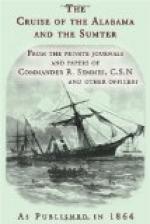The Dunkirk proved noteworthy in two ways. On searching through her papers, it appeared that besides her ostensible cargo she was also employed in what may be termed a kind of religious smuggling. Some Portuguese copies of the New Testament were discovered, together with a number of tracts in the same language, tied up in large bundles, on the back of one of which was the endorsement:—“Portuguese Tracts; from the ‘American Tract Society,’ for distribution among Portuguese passengers, and to give upon the coast to visitors from the shore, &c. When in port, please keep conspicuously on the cabin table for all comers to read; but be very careful not to take any ashore, as the laws do not allow it.”
It appeared, however, that the conscience of the society had pricked them for this concession to the majesty of the law, and a pen had been carefully run through the last sentence. A little lower down, upon the same packet, was written, “As may be convenient, please report (by letter, if necessary) anything of interest which may occur in connexion with the distribution; also take any orders for Bibles, and forward them to John S. Peerin, Marine Agent, New York Bible Society, No. 7 Beekman Street.”
The other noteworthy fact in connexion with the Dunkirk was the capture on board of her of one of the seven sailors who had deserted from the Sumter whilst lying at Cadiz ten months before. This man, whose name was George Forrest, was at once recognised, and on the day but one after his capture on board the enemy’s vessel, a court-martial, consisting of the first lieutenant (president); senior second lieutenant; master, chief engineer, and lieutenant of marines, with the captain’s clerk as judge-advocate, was assembled in the wardroom to try the prisoner for the crime of desertion. The evidence was, of course, simple enough, and the man was found guilty, and sentenced to lose all pay, prize money, etc., already due to him, and to fulfil his original term of service, forfeiting all pay and allowances, except such as should be sufficient to provide necessary clothing and liberty money.
That same afternoon another sail was descried and chased, and just before sunset the Alabama came up with and brought to, the fine packet ship Tonawanda, of Philadelphia, belonging to Cope’s Liverpool line, and bound from Philadelphia to Liverpool with a full cargo of grain, and some seventy-five passengers. Here was a serious matter of embarrassment; of the seventy-five passengers, some thirty or more were women, and what to do with such a prize it was hard to know. It was, of course, impossible to take the prisoners on board; yet Captain Semmes was, not unnaturally, reluctant to release so fine a vessel if he could by any possibility so arrange matters as to be able to destroy her. It was therefore determined to place a prize crew on board, and keep the ship in company for a time, in hopes that ere long some other vessel of less value to the enemy, or guarded from destruction by a neutral cargo might, by good luck, be captured, and thus afford an opportunity of sending the prisoners away upon cartel.




